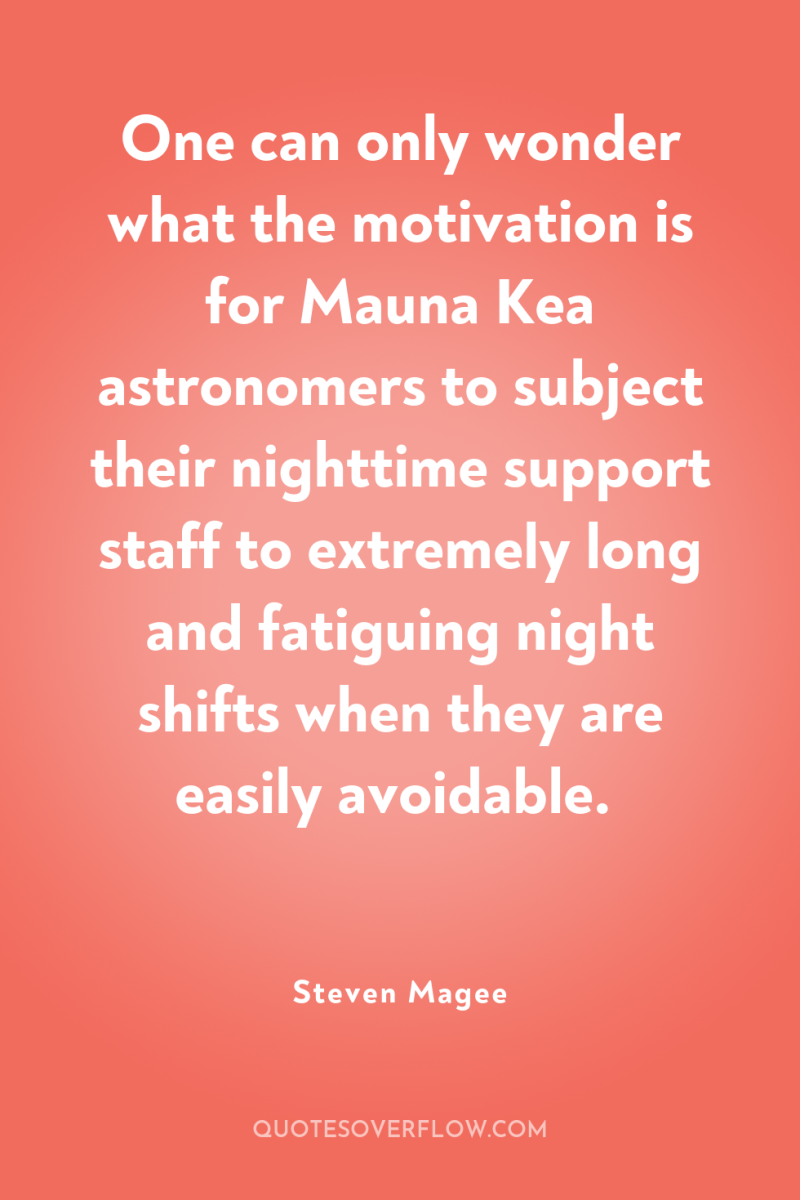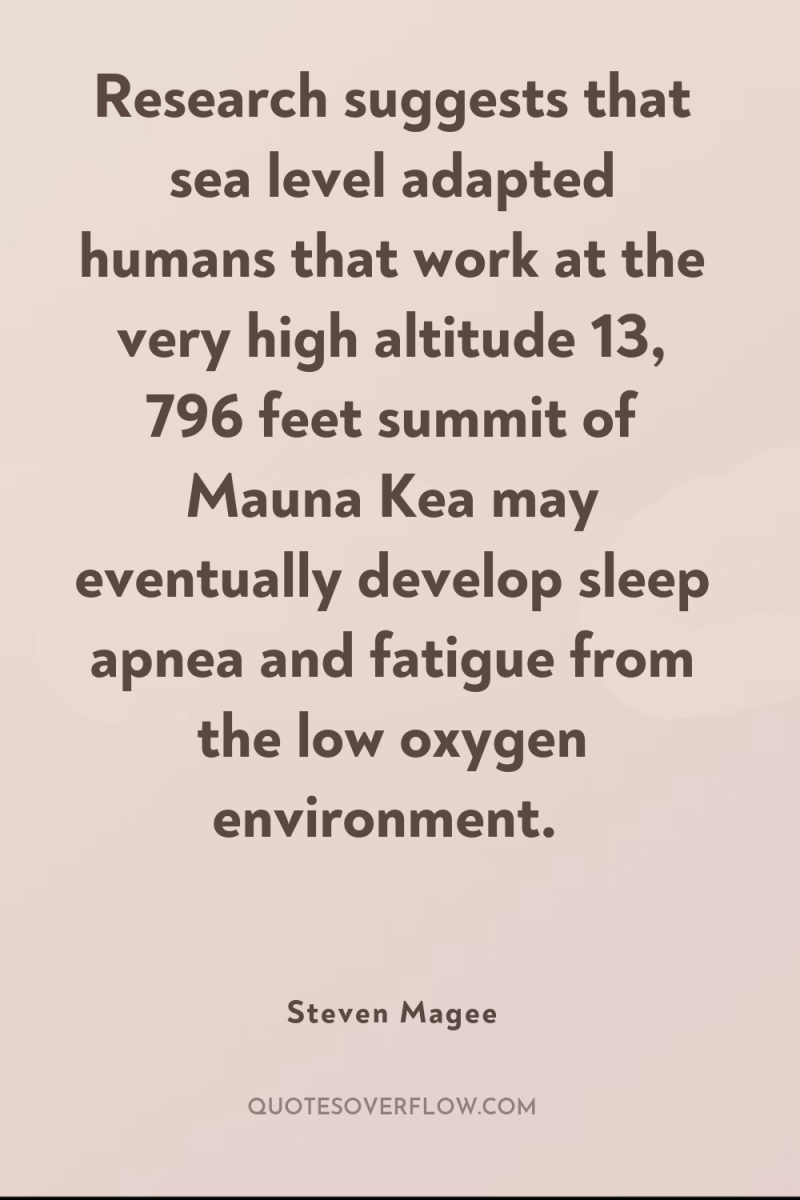
1
One can only wonder what the motivation is for Mauna Kea astronomers to subject their nighttime support staff to extremely long and fatiguing night shifts when they are easily avoidable.Steven Magee

2
Research suggests that sea level adapted humans that work at the very high altitude 13, 796 feet summit of Mauna Kea may eventually develop sleep apnea and fatigue from the low oxygen environment.Steven Magee
3
At the age of 45, most days in Tucson were spent feeling like I was on the summit of Mauna Kea, as I was exhibiting debilitating health symptoms that corresponded to what I saw at very high altitude. I was later to find that I had erratic low blood oxygen levels after almost a decade of high altitude work.Steven Magee
4
If you are looking for a career that may induce a myriad of health conditions into you, I can recommend working at the 13, 796 feet very high altitude summit of Mauna Kea, Hawaii, USA.Steven Magee
5
At the W.M. Keck Observatory on the very high altitude summit of Mauna Kea, there was no routine monitoring of mental functioning, blood oxygen levels, blood pressure or heart rate of workers.Steven Magee
6
The summit of Mauna Kea should never have been developed as it is not safe for humans up there. I am now locked into an endless loop of doctors visits for what appears to be classic very high altitude heart, lung & brain damage because I was unfortunate enough to have worked there.Steven Magee
7
I regard taking healthy sea level adapted children to the 13, 796 feet very high altitude summit of Mauna Kea as a form of child abuse.Steven Magee
8
The Mauna Kea night shift was an 18 hour night in wintertime at the 13, 796 feet summit (before sunset to after sunrise) with insufficient time for adequate sleep before the next night shift. Night shift was between 5 and 8 nights long and we slept at 9, 200 feet. We sat at a desk staring at four large computer monitors and a large cathode ray tube television. I would also use my Wi-Fi laptop computer. I would have extreme fatigue by the end of every night shift and have chapped lips which I now associate with exposure to the artificial light from the computer screens. A good day of sleep between shifts was rare and starting the next shift fatigued was normal.Steven Magee
9
I saw a guy faint at the W. M. Keck Observatory, he stepped out from the tour group and said to me "I'm feeling sick" and then his eyes rolled back and his knees gave way! The group caught him on his way to the ground and he got free emergency medical oxygen for half an hour before being evacuated off the summit by his tour group! ! ! His friends stated that he was considered the healthiest person in the group while he was gasping for breaths of life on the summit of Mauna Kea! Never saw him again.Steven Magee
10
I worked on Mauna Kea for over five years and saw my health severely degrade during that time. Thetwo long term summit workers that I knew well died of disease conditions, another worker went on tocommit suicide, and others were argumentative.Steven Magee
11
The summit of Mauna Kea was definitely a place where it was better to be a hard to replace skilled engineer than an easy to replace technician. It was my experience that once you had developed Mauna Kea Sickness that the management team would blatantly harass you out of your job using nasty inhumane human resources techniques.Steven Magee
12
When I was instructed to use medical oxygen to do my job at the W. M. Keck Observatory from 2001 to 2006, I was never told about the legal health information that is now posted on oxygen cylinders. My memories of the green medical oxygen cylinders that we would use daily is that they had no information on them and we were never given a recognised legal oxygen administration training course for routine daily use or a medical prescription from a doctor. We were shown the three oxygen cylinders at the facility and told to use them whenever we developed headaches, which was multiple times daily. It was common to find all three oxygen cylinders in use by other very high altitude workers and to have to line up to get a turn on the magical medical gas.Steven Magee
13
One of the biggest lies that is currently being told in the USA workplace is on the legally required OSHA poster: All workers have the right to a safe workplace.Steven Magee
14
When I saw how many people were objecting to the construction of the Thirty Meter Telescope atop Mauna Kea, I realized that there needed to be an open and honest discussion about the toxicity of the 13, 796 feet very high altitude summit and the health and safety issues of astronomical observatories.Steven Magee
15
When I worked in high altitude astronomy, the worst sickness that I experienced was not at the 13, 796 feet very high altitude summit of Mauna Kea Observatory (MKO) in Hawaii, it was at Kitt Peak National Observatory (KPNO) in Arizona at the much lower altitude of 6, 875 feet. Due to my very high altitude experiences, I knew that this strange sickness was not primarily caused by altitude sickness and was most likely Sick Building Syndrome (SBS). After reporting various behavioral problems in all of the staff to the management team, my contract was not renewed, I was unable to legally protect the health and safety of the workers that I was responsible for, troubleshooting of this environmental problem stopped and I left in a sickened state for my next position before I could find the root cause.Steven Magee
16
When I worked at the W. M. Keck Observatory on the 13, 796 feet very high altitude summit of Mauna Kea, we would routinely be engulfed in cold clouds of helium and nitrogen gas as we discharged it into the video camera systems daily. The management team never warned us that we were in a hazardous oxygen deprived environment during this activity that was known for its ability to adversely affect physical and mental health, and possibly bring on death by asphyxiation. .Steven Magee
17
Based on the medical evidence that clearly states that being above 10, 000 feet is hazardous to the health of sea level adapted humans, it is clear that all of the manned facilities on top of the 13, 796 feet Mauna Kea summit in Hawaii should be removed and the summit restored back to its native environment.Steven Magee
18
I have been through the OSHA system twice and I can confirm that I did not have the right to a safe workplace or whistle-blower protection on either occasion.Steven Magee
19
Altitude sickness, unregulated drugs and medical gas enabled workers to become drug abusers/addictsSteven Magee
20
Over-the-counter ‪‎drug‬ ‪‎abuse‬ or addiction was a problem that I observed at Mauna KeaSteven Magee
21
I consider myself fortunate that I spent three years working at 7, 775 feet before spending five years working at 13, 796 feet on the summit of Mauna Kea. I can only wonder how much more severe my long term very high altitude sickness could have been without the initial adaptation to the lower altitude.Steven Magee
22
The scandal with the Thirty Meter Telescope (TMT) atop Mauna Kea is how it managed to obtain a construction permit to build a manned telescope in a known biologically toxic environment to workers. How many more people need to die, get injured or develop long term very high altitude sickness that will last a lifetime?Steven Magee
23
A few years after working on Mauna Kea, I discovered that I had radiation sicknessSteven Magee
24
When I worked on the 13, 796 feet very high altitude summit of Mauna Kea we were advised to only use the medical oxygen after the daily headaches appeared and that just 15 minutes use was all that was needed to clear up the headaches for a while before we would need it again. We were not advised to use medical oxygen continuously as the Federal Aviation Regulations advises pilots to do. We were not advised to use pulse oximeters to monitor our blood oxygen levels or that the company medical oxygen should have been routinely administered only with our doctors prescription.Steven Magee
25
Oxygen deprivation and supplemental oxygen are both bio-hazards for Mauna Kea workersSteven Magee
26
Working on the summit of Mauna Kea was comparable to working on the hospital pulmonary ward with sick people sucking on oxygen cylinders.Steven Magee
27
During my five years on Mauna Kea, workers routinely displayed the symptoms of Cerebral HypoxiaSteven Magee